|
IBM » SELECTRIC « **************************************** THE RE-INVENTION OF THE TYPEWRITER 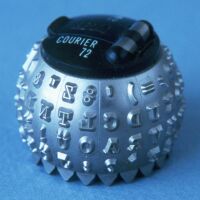 » SELECTRIC « 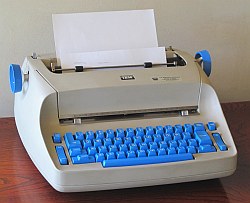 SN = 4005847 ( Model 72 ) (! This was one of the earliest produced !) electro-mechanical typewriter 115 V AC / 0.5 A IBM / USA (1961) 12 cpi; 102 cpl exchangable typing elements ribbon cassette free setting tabs W * D * H = 15" * 15" * 7" » SELECTRIC I « 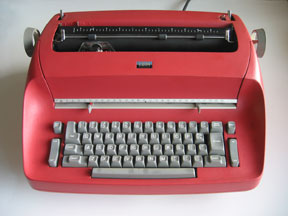 SN = 1138010 electro-mechanical typewriter 115 V AC / 1 A IBM / USA (1965) 10 cpi; 110 cpl exchangable typing elements ribbon cassette free setting tabs W * D * H = 18_1/2" * 15" * 7" » CORRECTING SELECTRIC II « 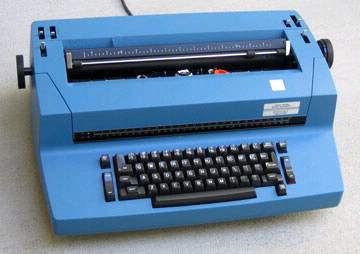 SN = 26-6427904 electro-mechanical typewriter 115 V AC / 1.2 A IBM / USA (1973) dual pitch 10/12 cpi; 130/156 cpl exchangable typing elements carbon- & eraser-tape cartridge free setting tabs W * D * H = 22" * 15_3/4" * 7_1/2" The RIBBON CASSETTE & CARBON / ERASER CARTRIDGE 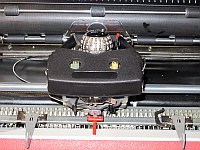 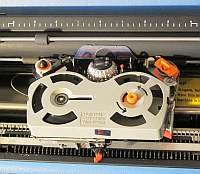 A SELECTION OF EXCHANGEABLE »ELEMENTS« ... 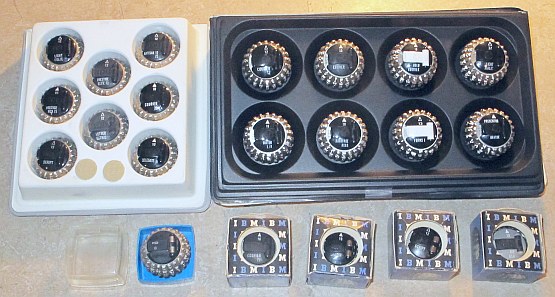 |
in SELECTRIC-II = 12 / PRESTIGE-ELITE-72
SELECTRIC-I = 12 SCRIPT
SELECTRIC = ADJUTANT (= special Clip )
=================================================================
in SquareBox (= IBM-Originals) | in BigBox (= GP-Technologies )
------------------------+-------+--------------------------------
12 / LIGHT ITALIC | 12 / COURIER 72
10 / PRESTIGE PICA 72 | 10 / COURIER
12 / SCRIPT | 10 / BOLD COURIER
12 / PRESTIGE ELITE 72 | 12 / LIGHT ITALIC
12 / LETTER GOTHIC | 10 / ORATOR L/A
12 / ARTISAN 12/72 | 10 / BOOKFACE ACAD
10 / COURIER 72 | 12 / FORMS I
10 / DELEGATE | PRESENTOR ORATOR
-----------------------------------------------------------------
in Acryl/PlasticBox (= REMINGTON ) #563-10
-----------------------------------------------------------------
in 4 Single Boxes (= IBM ) 10 / COURIER 72
10 / ORATOR
12 / SCRIPT
10 / 915-OCR
=================================================================
HISTORICAL REMARKS:
*****************************************************************
Source (A) Industrial Designers Society of America (IDSA)
=========================================================
(* FIDSA = Fellow of IDSA )
In 1961 IBM introduced a revolutionary electric typewriter, the
»SELECTRIC«, which replaced the standard typebars with a moving
interchangeable spherical "golf ball" printing element, while
the carriage remained fixed. Development began in 1951, and the
sculptured housing was designed starting 1959 by Eliot F. Noyes.
Eliot Fette Noyes (1910-1977 * FIDSA), was a US architect and
industrial designer who was born in Boston, studied architecture
at Harvard (1932-1938) and was employed by Marcel Breuer and
Walter Gropius after graduation. He worked as a curator at the
Museum of Modern Art and was appointed director of the new
department of industrial design there in 1940. In 1941 he
organized a competition for the museum to discover imaginative
designers for contemporary living. Prizes were awarded to Charles
Eames (1907-1978) and Eero Saarinen (1910-1961), both on the
faculty of Cranbrook Academy, for innovative furniture designs,
which were then exhibited by the museum as "Organic Design in
Home Furnishings."
After serving in the air force during the war, Noyes was design
director with Norman Bel Geddes. When Bel Geddes' office closed
in 1947, one of the unfinished projects was a »Model A« electric
typewriter for IBM.
Noyes opened his own office and finished the job for IBM. He was
retained in 1948 by Thomas J. Watson Jr. for IBM product design
and in 1956 to develop a unique IBM corporate style and image
similar to Olivetti, IBM's key competitor. He did so with help
from Paul Rand, Marcel Breuer and Charles Eames.
Source (B) IBM Archive
======================
In 1961 IBM introduced a revolutionary way to make a typewriter
work. This was the IBM »SELECTRIC« Typewriter, which replaced
type bars and moving carriages with a printing element, a sphere
no larger than a golf ball, which bears all alphabet characters,
numbers and punctuation symbols. The element moves along a
slender metal rod, tilting and rocking at very high speed as it
selects the desired character.
The IBM » Selectric I « was bigger, had some improvements
and was easyer to maintain (case opening from top w/o tools).
The IBM » Selectric II « Typewriter introduced in 1971, also
features a number of additions to typing technology. Containing
the "dual-pitch" mechanism, the » Selectric II « Typewriter
enables the typist to switch from ten-pitch (ten characters per
inch), commonly used for routine correspondence, to twelve pitch
(twelve characters per inch), for use in typing business forms.
In 1973, the IBM » CORRECTING SELECTRIC « Typewriter became the
first machine in the history of typing to actually make typing
errors disappear from original copies. Equipped with a special
"Lift-Off" tape, the typewriter enables a typist to virtually
"lift-off" erroneous characters from typed copy. Activated by
depressing a correcting key, the "Lift-Off" tape completely
removes ink impressions from the paper, allowing the operator
to simply type in the correct character and continue typing.
Since their introduction, IBM »SELECTRIC« Typewriters have become
among the most popular typewriters for training in schools and
universities, as well as in most aspects of business.
A German ADVERTISEMENT for the IBM » SELECTRIC « in the '70s
=================================================================
I remember a big white billboard in Berlin's underground stations
that just said ...
+---------------------------------------------------------+
|
| schreIBMaschine |
+---------------------------------------------------------+
... the German word ( written in Courier ) for typewriter!
impressum:
*******************************************************************
© C.HAMANN http://public.BHT-Berlin.de/hamann 06/07/11
|